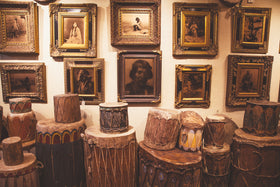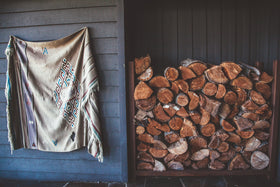What is Native American Parfleche?

The word parfleche was coined by the French fur traders. It was derived from the French word “parer” meaning defend and “fleche” meaning arrow, as the hide was tough enough to be used as a shield and deflect an arrow.
The Plains and Plateau Indians had an abundant source of hides in the buffalo and elk they hunted, but as they were nomadic, they had little opportunity to tan the skins. In order to preserve the hides they had to be cleaned, removed of their hair, stretched and then dried. The process created a stiff, durable leather that was used for countless items including packets, bonnets, pouches, bonnet cases, knife sheaths, drums, and shields.
The process of making parfleche began with soaking the fresh hide. After, it was stretched and staked to the ground with the hair side down, or stretched tightly on a wooden frame. The flesh and fat of the animal was then removed by scraping at the hide with a fleshing tool. The first fleshing tools were merely sharpened stones but progressed into elk antlers with an attached jade or iron bit and then onto a tool called a gun barrel scraper. Gun barrel scrapers were created by taking an 8" piece of gun barrel and flattening one end into a chisel shape with serrations. The handle would then be wrapped with hide. To help remove the hair more easily, the natives used ashes. The lye in the ashes helped soften the hide making it easier for the scraper to remove the remaining hair. For the making of a shield, which needed to be extra hard, the parfleche was alternately soaked and dried over a slow smoky fire.

After the demise of the buffalo, parfleches were made with steer hide. Native American women historically fashioned the parfleche into containers and decorated them with brightly colored geometric designs. A porous buffalo bone served as an effective paint brush. Sometimes the hide was incised to highlight a design. The original containers had graphics that were maps, geographical depictions such as rivers and mountains, or symbols that told the family’s stories. Once the parfleche left the family, the story was lost and the parfleche became Indian art rather than a meaningful storyteller.
In the plateau where the tribes were less mobile, the parfleche was a part of weddings ceremonies, with relatives of the groom giving the couple parfleche containers and relatives of the bride giving cornhusk bags. These were then used by the new family to hold clothing, bonnets, personal items, tools, and dried meat.
The most common Native American parfleche container is the packet. For this, the hide was trimmed to a rectangular shape, folded at the sides to overlap, and the ends folded towards the center to form an envelope. The most common size is approximately 1' x 2'. These containers were used to hold clothing, bonnets, personal items, tools, and dried meats.
Click here to view our extensive collection of Native American parfleche.




